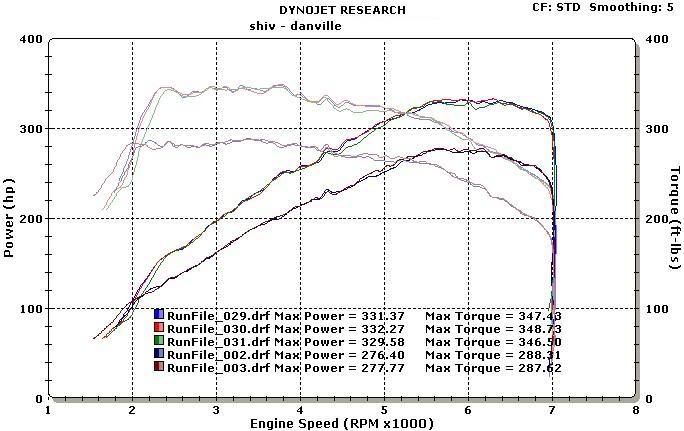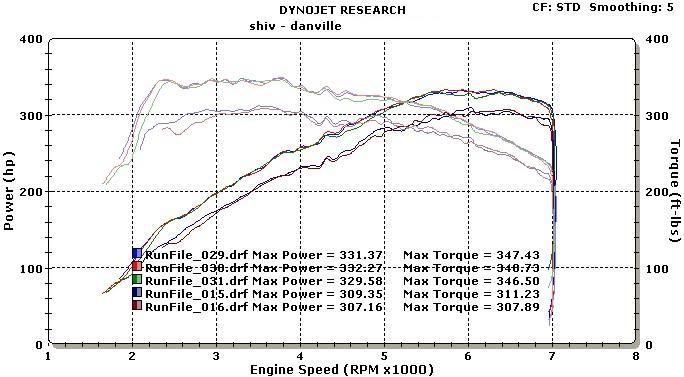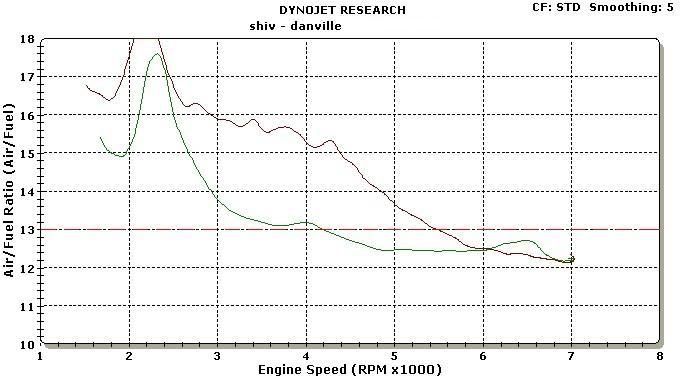Those who have been following our progress over the last couple of weeks probably know where we last left off. The last we left off, we control over spark timing, boost control, and some marginal control over fuel. As of last night, we got FULL control over fuel. So, as it stands, we have control over everything we ever wanted to get in control of

For those who are haven't been following our progress, here's a little synopsis along with a bunch of dyno graphs.
Two weeks ago, we purchased and drove home in our brand new 335i Coupe (space grey, red interior, 6sp manual). After 75 miles of break in (lol), we brought it to Modacar in Livermore, CA. Although we have a fancy AWD Dyno Dynamics dyno, most people are more familiar with Dynojet readings than anything else. However, Modacar's dyno does read lower than other Dynojets. Running our normal 91oct gas (the best we get in CA unfortunately), our car put down a repeatable 276-277whp and 287-288lb-ft of torque. On other dynojets, the car would probably have put down around 285whp and 295lb-ft of torque (as measured by Automobile magazine, for instance). But since this is the dyno we are using, we're going to stick with these numbers. Just as long as we don't move around from dyno to dyno, all this numbers are perfectly valid and useful for comparing against one and another. Also, all runs were done in 4th and taken right up to fuel cut (~7000rpm)
Stock Run:

After baselining the car, we started our tuning process. We opted to use a slightly modified version of our Xede computer. It is similar to the unit we use for Evos except that it need to read a different crank trigger (60-2 vs 4 teeth) and a T-MAP sensor (0-5 analog voltage vs. Freq wave in Hz). There were also some other sensor differences but we could adjust for that in the Xede software. The first thing we got in control of was ignition timing. We experimented with a lot of different approaches. We found that we could add in timing during cruise to improve fuel economy as well as reduce oil temps. Partial throttle torque was also improved. The next thing we got in control of was calculated load. This had an effect on the boost curve and some secondary effects on fueling. Not nearly enough control as we were looking to eventually get but good enough for an initial stab at tuning. And the results were reasonably good given our inability to control fuel properly.
Results (stock vs. 1st attempt):

So what is exactly wrong with the fuel curve? Check out this Air/Fuel chart:

First of all, feel free to ignore the first 1000rpm of the AFR trace. Tailpipe sniffing widebands suffer from a time delay especially at low engine speeds when exhaust velocity/volume is too low for them to get an accurate reading of what is happening at that exact time. But even looking above 3000rpm, we saw AFRs as lean as 15.5:1. And this under full boost! Lean to say the least. At higher engine speeds, AFR worked its way back into the nice and rich side of things. But the AFR in the midrange was odd. Odd enough to make me look for air pumps which would explain the lean readings. I didn't find any. Obviously BMW tuned this car this way for a reason. Probably for fuel economy and certainly for emissions. Does it compromise power and safety? We wonít know for sure until we try something else, no? More on that later on. In our first tuning attempt, we made very very little change to AFR. If anything, our tuning resulting in it being slightly richer at high rpm ("tuned" is the green line, stock is the blue line). But with AFR so lean in the midrange, we really wanted to get full control over fueling ASAP. But at this stage, all most of our gains came from tweaking the timing curve, bumping up boost by ~1psi and eliminating much of the high rpm boost taper. And the results were ok. With this half assed toon...er tune, we picked up over 32whp at peak and a whopping 70whp at 7000rpm.
That was last week. This week, we made some really good progress. Not only did we get full control over boost but we also got
every last bit of control of fueling. Yay! This means that we can try all sorts of fuel/timing/boost combinations to see which ones work the best (makes good power with good repeatability, low temps and sufficient knock resistance.) Another thing we did was made a cat-back exhaust system for it. Nothing fancy. Just a one-off prototype that we pieced together with 2.5" crushed bent piping and standard magnaflow mufflers. It replaces the exhaust just after the downpipes. The two factory cats in the downpipe are still in place. But the secondary cats, along with a bunch of bendy exhaust tubing, was all replaced. If we can make good power with this quickie exhaust, we should do really well with a production version offering larger volume mufflers, mandrel bends, etc,. In a way, I wish I had waited to put on the exhaust later and just re-dynoed the car with just our new-found fuel and boost control. But I didn't. So shoot me. We could always stick the stock exhaust back on next week and dyno it again. But hey, I was impatient for a fast car that actually
sounded fast

With all the engine controls we ever wanted
and a new exhaust, the car picked up good power. We limited boost to 11psi for now since we are still running our 91oct pump gas. But with proper boost control now in our pocket (and a 3rd boost control solenoid under the hood being controlled by the Xede), we had a rock solid boost curve with 11psi at 2500rpm, holding flat until 6000rpm and then gently dropping off to 10psi by 7000rpm. Before, during our "first attempt", it would bounce around a little bit +/- 1psi.
New Results
Stock vs. Xede Tuned and cat-back exhaust
91oct

Even compared to our "first attempt", our second attempt with exhaust stacks up well:

However, the biggest improvement we were able to get was with respect to Air/Fuel ratio. Here's an AFR graph comparing a stock car making 277whp to our tuned car making 332whp (green curve):

Yes, the tuned run is running
over 2 FULL points richer in the midrange than the stock run! In fact, it substantially richer than the stock run everywhere except 6000rpm where we were able to sneak a bit more power out by running a little leaner than stock.
Still, by virtue of the new fuel mapping, it's reasonable to say that the tuned car is running more knock-free, safer and cooler than the stock car. All while making a boat load more power and torque. All in all, we're pretty happy with the car. It is fast as hell and now sounds nice as well. In first gear, we get virtually no traction at full throttle. In second gear, the car is capable of spinning its wheels as well if the road gets even slightly bumpy. If you drive with the traction control on (yuck), you see that light flash on and off all throughout the first 3 gears

So how much power is left in there? Well, it's clear that we are limited by our 91oct gas. With every 0.5 degrees of timing I sneaked in, the car would pick up a few horsepower. So with better gas, we'll see more power. And with race gas, I'm sure we'll see big gains. But on 93 octane, I'd expect to see another 10whp. We'll probably pick up some more power if we were to eliminate the factory cats in the downpipes. But that would have an big impact on emissions which is something we want to avoid at this point. There are still a few things we want to try out. There's still more power to be had with our current set-up. But for now, I'm just going to beat the tar out of the car and put it through its paces. One step at a time.
There were some people videotaping todayís dyno session. Iíll try to get a hold of some of that video and post it up. Next week, we're going to bring out our video camera and do some on-the-road acceleration test, pitting our tuned 335i against our 100% stock Porsche 996 and our 100% stock Evo IX. Should be fun!

Stay tuned...
Cheers,
Shiv
Vishnu Performance Systems